#butterlaneantiques
Text
Alternative Engagement Rings
Alternative engagement rings have been popping up all over the internet, but why?
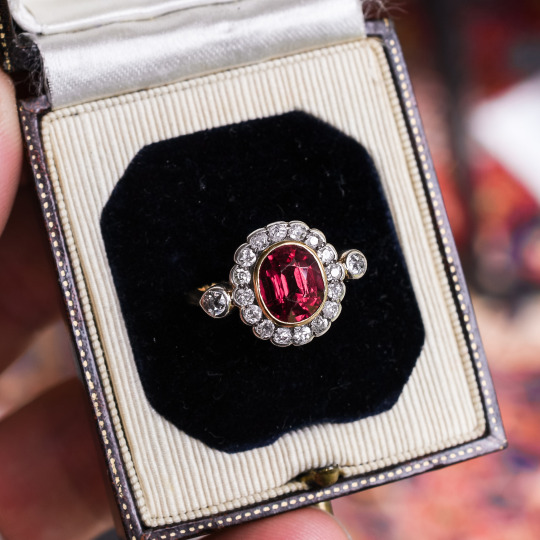
The classic engagement ring features a white diamond/s, which don't get me wrong, they are classically beautiful but why not switch it up a bit? Adding a pop of colour to your engagement ring can be a fun addition to your everyday look.
Here are some examples below...
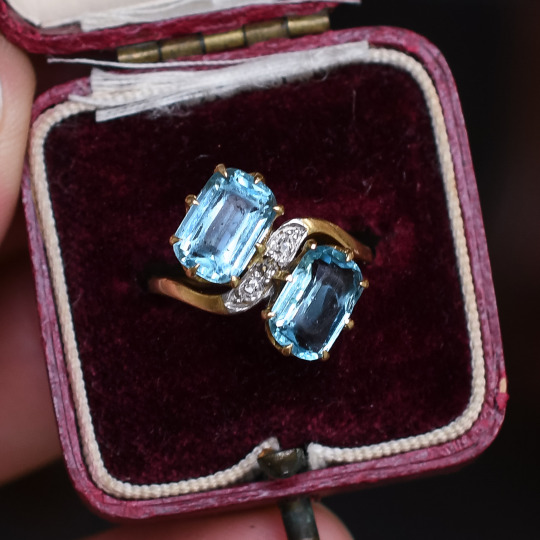
Superb antique crossover ring dating from the Art Nouveau period, circa 1910. The head is set with two 1.75ct emerald cut aquamarines - in the 'toi et moi' style (translates to you and me) - with a seam of diamonds separating them along the middle of the band. Crafted in 18 karat gold.
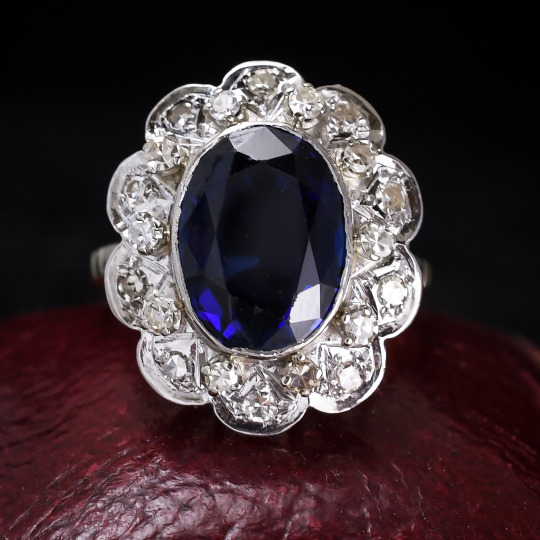

(Source: butterlaneantiques.com)
#antiquejewelry#alternativeengagementring#engagement#engagement ring#ring gemstone#victorian jewelry#vintage ring#beautiful rings#engagement ideas#butterlaneantiques
10 notes
·
View notes
Photo

📸@_butterlaneantiques Victorian pavé set turquoise and pearl heart pendant and gold fancy-link guard chain. Follow the link in our bio for more details. #antiquejewelry #butterlaneantiques #VictorianJewelry #goldchain #heartpendant #heartpendant #locket #pearls #pearl #turquoise #antique #antiquenecklace #pendant #vintagestyle https://www.instagram.com/p/CJ5MJJalKnY/?igshid=nmqryxbbesh4
#antiquejewelry#butterlaneantiques#victorianjewelry#goldchain#heartpendant#locket#pearls#pearl#turquoise#antique#antiquenecklace#pendant#vintagestyle
0 notes
Photo
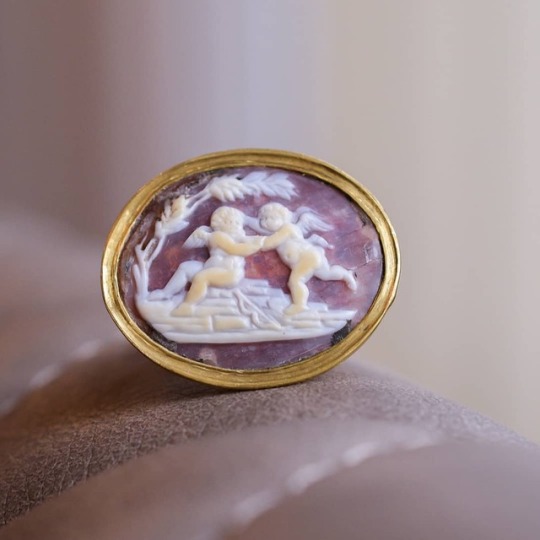
#Repost @_butterlaneantiques • • • • • A fine Georgian cameo ring depicting two winged cherubs frolicking on a rock. The shell cameo is masterfully executed; it will have been carved in Italy, with great detail and perfect contrast between the subject and background. The ring itself was made in England, modelled in 22k (head) and 18k gold (band) - it dates from circa 1830. Follow the link in our bio for more details. #antiquering #love #cameoring #GeorgianJewelry #butterlaneantiques #cameo #cherubs #showmeyourrings #ringsofinstagram #GeorgianRing #antiquejewelry #oldgold #operaeopera https://www.instagram.com/p/Btq7B-yhxGt/?utm_source=ig_tumblr_share&igshid=yu9xuu0s00fz
#repost#antiquering#love#cameoring#georgianjewelry#butterlaneantiques#cameo#cherubs#showmeyourrings#ringsofinstagram#georgianring#antiquejewelry#oldgold#operaeopera
0 notes
Photo
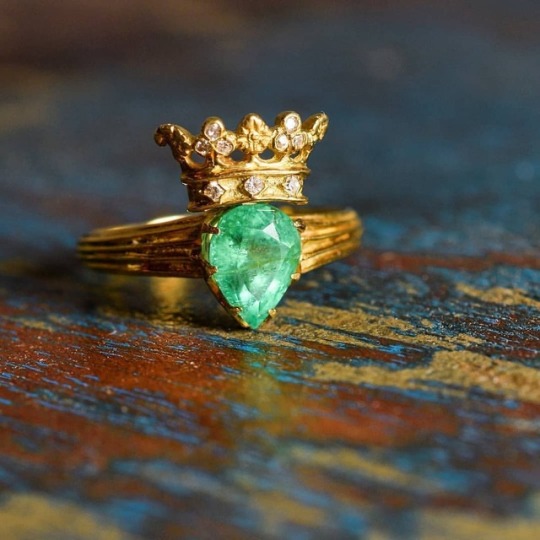
Droooools 👸💫💍👑💎 . . . . @Regran_ed from @_butterlaneantiques - A superb crowned heart ring dating from the late #Victorian era. The heart-shaped emerald rest beneath a gleaming diamond-set crown - all intricately worked with a great level of detail. Modelled in 18 karat gold with am interesting grooved band. Follow the link in our bio for more details. #antiquering #butterlaneantiques #showmeyourrings #crownedheartring #emeraldring #VictorianJewellery #oldgold #ringsofinstagram #crownedheart https://www.instagram.com/p/Bp56SBoly_q/?utm_source=ig_tumblr_share&igshid=i8setdx5xswi
#victorian#antiquering#butterlaneantiques#showmeyourrings#crownedheartring#emeraldring#victorianjewellery#oldgold#ringsofinstagram#crownedheart
0 notes
Photo
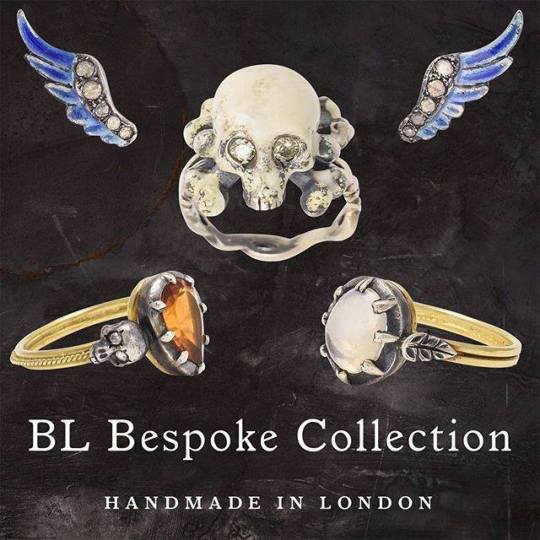
Have you seen the new @_butterlaneantiques BESPOKE collection? These new antique-inspired treasures are handmade in London exclusively for #ButterLaneAntiques. . Hop over to their IG to take a look & let me know what you think! I’m crushing hard on those wing earrings. #sponsored . #BLBespoke #jewelrylover #rings #mementomori #skullring #antiquestyle #madeinLondon #bespokejewellery #diamondsinthelibrary See more on Diamonds in the Library's Instagram: https://ift.tt/1nw2zKI https://ift.tt/2KNZGou
2 notes
·
View notes
Text
Colour Change Sapphires
Most people do not not believe these exist, until they see one...
Rare and beautiful, these stones will change colour depending on the lighting, whether it be under a bulb or in natural light. Most colour change sapphires come from Sri Lanka and Tanzania, with new material being produced recently in Madagascar too.
Art Deco 3.74ct Colour Change Sapphire Solitaire Ring
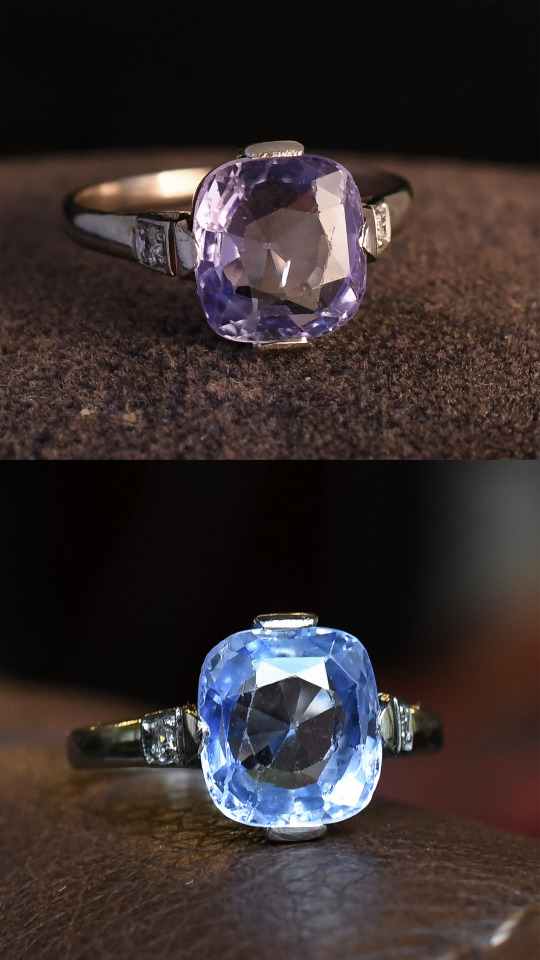
Superb antique solitaire set with an incredible natural colour-change sapphire, changing from an electric light blue in daylight to violet under an incandescent (electric) bulb. The principal stone is a 3.74ct certified sapphire, cushion cut, set between two diamond shoulder accents in a 1920s period mount. Subtle hand engraved details decorate the gallery, and the stone is secured between four wide prong mounts.
Colour change gemstones possess the ability to appear as two completely different colours depending on the type of light they're viewed under. Although daylight and electric light both appear as "white" light, the former is much richer in green wavelengths and the latter is richer in red wavelengths. When combined with a gemstone's ability to absorb specific wavelengths of light, this difference in the two light sources can be enough for certain special gemstones' body colour to change entirely. Alexandrite is the best known colour-change gem, but some sapphires and some garnets can also behave in this way.
(source: butterlaneantiques.com)
#sapphire ring#colour change#art deco jewelry#art deco#sapphire rings#engagement ring#butterlaneantiques
7 notes
·
View notes
Text
Opal Stone
Opals have been compared to fireworks, galaxies and even volcanoes. With their beautiful array of colours, I can see why. In Ancient Rome, it was given the name 'Opalus' , meaning 'precious stone'. Opals were seen to be more rare than diamonds or rubies due to their flashes of light and colour, as they were known to be the stone of myths and dreams.
Many different cultures believed the stone brought power, luck and health and even today, this belief still remains.
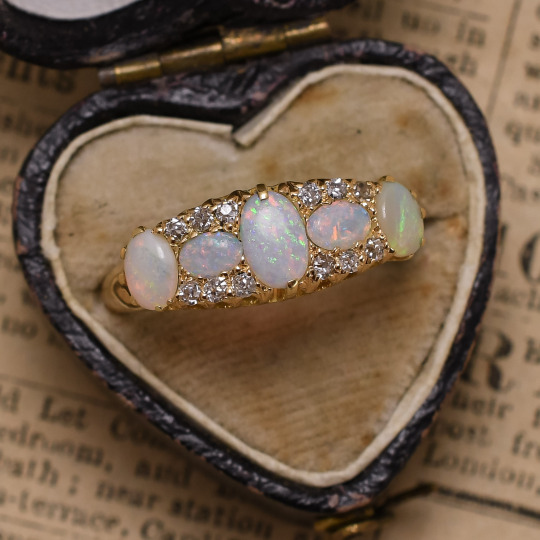
So what does it mean if someone gifts you an opal ?
Because of stone's connection with the star sign Libra, it is often related to feelings of passion, love and desire.
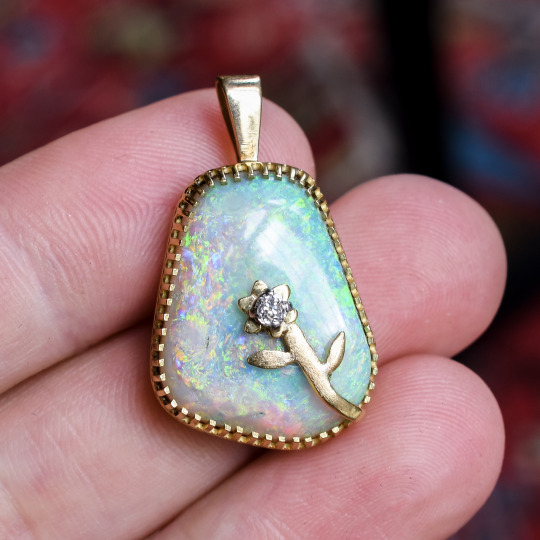
An enchanting asymmetrical pendant, its form determined by the huge chunk of opal that makes up its body. The opal displays excellent play of colour, with shimmering greens and deep blues punctuated by flashes of orange and red that come and go as it moves in the light. It's held in place by 53 slender claws, and features a diamond-set flower appearing to grow over the front towards the centre. Crafted in 18 karat gold and dating from the 1960s.
Here are some more examples of Opal Jewellery.


(Source: butterlaneantiques.com)
#opalstone#opaljewelry#opalring#antiquejewelry#gemstones#pretty rocks#healingstones#butterlaneantiques
5 notes
·
View notes
Text
Opal Stone
Opals have been compared to fireworks, galaxies and even volcanoes. With their beautiful array of colours, I can see why. In Ancient Rome, it was given the name 'Opalus' , meaning 'precious stone'. Opals were seen to be more rare than diamonds or rubies due to their flashes of light and colour, as they were known to be the stone of myths and dreams.
Many different cultures believed the stone brought power, luck and health and even today, this belief still remains.

Stunning antique opal five-stone ring dating from the early 20th century, circa 1910. The stones are bright and lively with excellent play-of-colour that appears to dance as it moves in the light - the full rainbow colour spectrum on display. It's crafted in 18 karat gold with fine claw settings and a fluted gallery.
(source: butterlaneantiques.com)
So what does it mean if someone gifts you an opal ?
Because of stone's connection with the star sign Libra, it is often related to feelings of passion, love and desire.
#opalring#opalstone#opaljewelry#edwardianjewelry#edwardian#edwardian era#jewelry for women#butterlaneantiques
3 notes
·
View notes
Text
Gypsy Rings
Gypsy rings were very popular during the late Victorian era, especially between 1885 - 1900. This was a time in jewellery making where jewellers favoured diamonds and gemstones such as sapphires and emeralds. This stone was made the primary feature, with a thick band which were worn by both men and women. And years down the line they are seen as a popular choice for alternative engagement rings.

In a gypsy ring setting, the stone appears to sit flush with the surrounding metal. This provides more protection to the gemstone from damage and everyday wear. Wealthy Victorian women loved this style of ring, as when travelling, they feared bandits might steal their jewels and it would make it harder to take the gem out of this setting.


Excellent Victorian three-stone gyspy ring set with a blue sapphire flanked by two chunky old cut diamonds. Crafted in solid 18 karat gold, the stones rest in rub-over settings: two .16ct old Euro diamonds and a natural .36ct blue sapphire. A partially legible inscription inside the band reads 'R.E.J. to E.M.J. Febr.. 6... 189...' suggesting it was made and first exchanged during the final decade of the 19th century.
(Source: https://www.butterlaneantiques.com/)
#gypsy ring#Victorian ring#gypsy jewelry#sapphire ring#victorian era#victorian history#butterlaneantiques#alternative engagement ring
4 notes
·
View notes
Text
Memorial Jewellery
Hair work jewellery originated in France and England in the 1700’s, evolving from the craft of wig makers. Initially, the jewellery functioned as a mourning memento and was a common funeral gift in the 18th century. Rings, brooches, necklaces, watch fobs, earrings and much more were crafted from the lock of a loved one.



Cool Regency period key pendant, circa 1810. There's a round locket compartment in the centre of the bow, currently home to a tightly woven lock of hair (the Georgians were like that..), and features intricate filigree ropework details along the shank and unusual (but quite lovely) hand-engraved detailing to the bit. As you can probably tell, I just googled "anatomy of a key" and it was somewhat illuminating - I would have only hit on one of those three descriptors. The significance of the key is clear here, not the usual "key to my heart", but rather it's a memorial piece, so the key unlocks a memory of the deceased. Crafted in 15 karat gold, converted from a brooch.
(Source: butterlaneantiques.com)
#memorial jewelry#hair jewelry#memorial#victorian era#georgian era#georgian style#antiques#antiquejewelry#memorial art#butterlaneantiques
4 notes
·
View notes
Text
Acrostic Jewellery
Popular in the Georgian and Victorian eras, acrostic jewellery uses the first letter of each gemstone to convey a secret message or a token of affection.

(source: https://www.thejewelleryeditor.com)
First created by Jean-Baptiste Mellerio, he designed pieces that spelled 'J'adore'. The most popular messages, regard, beloved and dear began in the Georgian era and flourished throughout the Victorian period. I think a truly romantic trend such as this should still be popular today!
#acrostic#acrostic jewelery#victorian jewelry#georgian jewelry#history of jewelry#acrostic jewelry#secret message#butterlaneantiques#multi stone
2 notes
·
View notes
Text
Arts & Crafts Multi-Gem Brooch Attributed to Dorrie Nossiter
An exciting multi-gem antique brooch, attributed to the jewellery designer Dorrie Nossiter. She was an Arts and Crafts jewellery maker/designer known for her nature inspired jewellery. She was born in 1893 in Birmingham and attended the Municipal School of Art from 1910-1914. She studied drawing with a focus on drawing plant form and after this she and her family moved to Dorset where she was inspired by the colours and shapes in her garden. Nossiter then moved to London where she created most of her work.
This brooch is crafted in silver with small gold pommels, set with an array of colourful gemstones. The main event, a large 23.8 carat amethyst displaying an intense pink/purple with an open backed setting allowing the light to shine through the stone enhancing it's vibrancy. Surrounding the stone, a cluster of citrine, baby blue zircon and tourmaline. The colour combination of the stone are gorgeous, and it dates from the Art's & Crafts period. A fabulous attribution to Dorrie Nossiter herself.


#antiquejewelry#butterlaneantiques#antique jewelry#fine jewelry#antiques#butter lane antiques#vintage#arts and cra#arts and crafts#brooches#brooches are back#brooch#art nouv#art nouveau jewelry
1 note
·
View note
Text
Art Deco Jean Painlevé Bakelite Seahorse Bangle
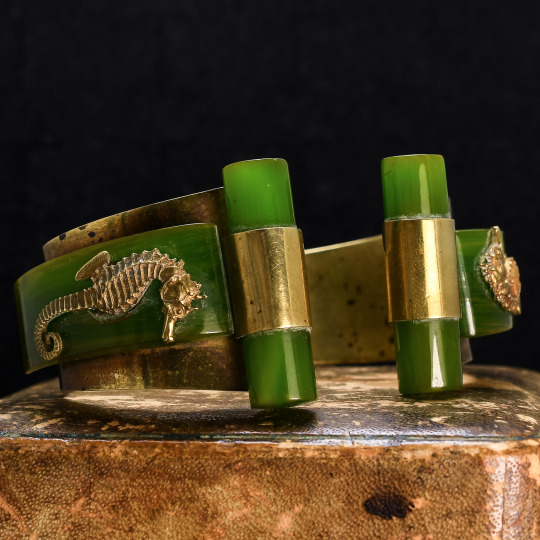
An especially cool Jean Painlevé bangle dating from the Art Deco period, circa 1935. Jean Painlevé, a French film maker with an interest in biology. Painlevé’s breakthrough came in 1935, with his film "L’Hippocampe" or The Seahorse. In the wave of his success, in 1936, Painlevé and his wife commissioned a range of seahorse jewellery. This piece, a yellow metal torque bangle, topped with bakelite and two gold coloured seahorses. It's not your typical shaped bangle, but is more oval shaped, with two "cylinders" of bakelite to slip your wrist through.

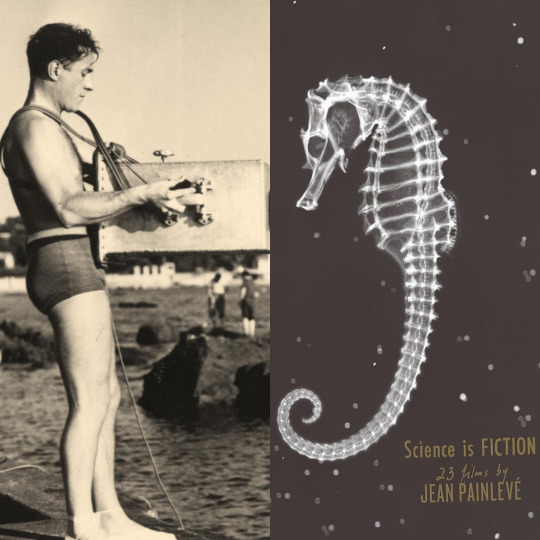
#antiquejewelry#antique jewelry#butterlaneantiques#fine jewelry#antiques#butter lane antiques#art deco#art deco jewelry#art deco style#art deco fashion#jean pain#jean painlevé#the seahorse
0 notes
Text
Edwardian "Miss Jessica Waters" Photo Locket

Jessica Waters was a theatre actress active during the early years of the 20th century. There's little information about her online, but judging by these pieces she must have been quite famous in her day, touring the old theatres and music halls of England (and who knows, maybe further afield). There's a snippet in The Cambria Daily Leader: "GRAND THEATRE SWANSEA. MONDAY, DECEMBER 7th, 1914, For Six Nights at 7.30. Visit of Miss Jessica Waters, supported by the No. 1 London Company. Monday, Tuesday, and Wednesday- MARY GOES FIRST. r Thursday, Friday, and Saturday- THE DUST OF EGYPT." And a couple of mentions in the Oxford Journal Illustrated newspaper. Again in 'The Dust of Egypt' (this time in October 1912) and in 1909 as "Actress at New Theatre".
The play - The Dust of Egypt - that Miss Waters starred in again and again was written by Alan Campbell, and seems to have been something of a sensation in its day. From the Eastbourne Chronicle, December 19th 1914:
MISS JESSICA WATERS and Company In the Laughter-making Farce,
'The Dust o f Egypt.'
By Alan Campbell.
In 1913 it was staged in Los Angeles, as documented in the ^Los Angeles Herald 20th March 1913: "BEGINNING NEXT SUNDAY AFTERNOON—FIRST PRODUCTION IN AMERICA. The Morocco Producing company will give the first American production of Alan Campbell's new comedy success. ‘The Dust of Egypt” NOW THE REIGNING LAUGHING SENSATION OF THE LONDON STAGE." And it appears to have been made into a movie in 1915 - directed by George D. Baker. imdb.com describes the film as, "An imperious Egyptian princess awakes from a 3000-year trance and wreaks comic havoc in the modern world, but it all turns out to be the dream of a young man, inspired by a mummy left in his care overnight." Wild, no doubt.
#antiquejewelry#antique pendant#miss jessica waters#the dust of egypt#edwardian#edwardianjewelry#butterlaneantiques#jewelry history
1 note
·
View note
Text
MEDUSA

(Source: butterlaneantiques)
Medusa is the best known of the three monstrous Gorgon sisters. Our earliest reference to the Gorgons is found in Hesiod's Theogony, but it was Ovid who really fleshed out the story - in the Metamorphoses - where he describes Medusa in her youth:
"Medusa once had charms; to gain her love
A rival crowd of envious lovers strove.
They, who have seen her, own, they ne'er did trace
More moving features in a sweeter face.
Yet above all, her length of hair, they own,
In golden ringlets wav'd, and graceful shone."
Her beauty caught the eye of Poseidon, who forced himself upon her in a shrine to Athena. Athena was furious; she turned Medusa's hair into snakes, and made her face so hideous that anyone who saw it was instantly turned to stone (literally petrified). In most versions of the story, Medusa was killed by Perseus who was given various items to help him on his quest: a mirrored shield from Athena, a sword forged by Hephaestus, and Hades's helm of invisibility. While looking at the reflection in the shield, Perseus was able to behead the Gorgon, at which point Pegasus flew out of her severed neck. He went on to use her head - which retained its petrifying effect - as a weapon, using it to transform the Titan Atlas into stone (where he still stands in North Africa as the Atlas Mountains), before eventually giving it to Athena.
Although Medusa is commonly regarded as a monster, her head has often been seen as a protective amulet to keep evil away. Indeed, the name Medusa comes from the ancient Greek word meaning "to guard or protect".
#medusa#mythology#roman mythology#serpent#myth#gorgon#victorian era#victorian jewelry#antique jewelry#antique brooch#medusa jewelry#mythology jewelry#butter lane antiques
1 note
·
View note
Text
Regency Period Dendritic Agate Butterfly Brooch
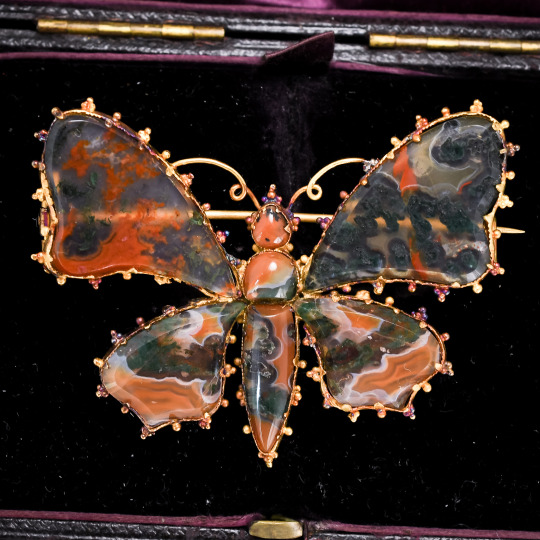
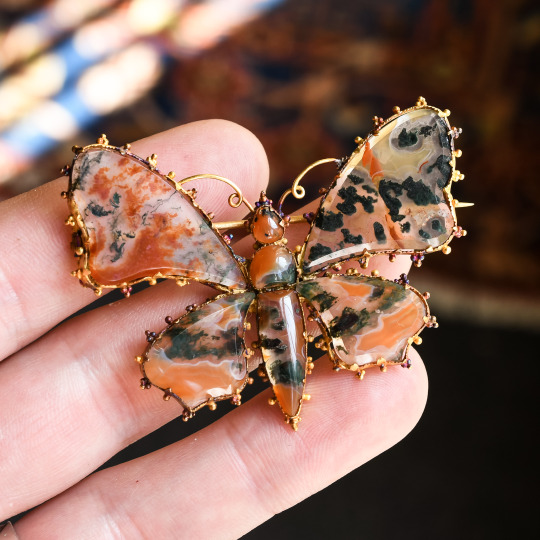
A magnificent antique butterfly brooch dating from the Georgian Regency Period, circa 1810. The wings are set with attractive dendritic agate panels flecked with red, green, and orange; beautifully hand cut to form the fore and hind wings, and body sections. They're mounted in 15 karat gold embellished with alternating triple and single pommel details as well as looped antennae. Exceptionally finely made, and a good large size at 6.1cm width.
(source: butterlaneantiques)
1 note
·
View note